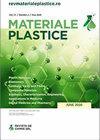The Importance and Necessity of New Bio-Based Materials in Industrial Design
IF 0.6
4区 材料科学
Q4 MATERIALS SCIENCE, MULTIDISCIPLINARY
引用次数: 1
Abstract
Main goals like technical innovation, costs and respect for the environment urge us to discover finer, lighter, biodegradable, and more �intelligent� materials in their functionality. The development of industrial design is motivated by criteria such as the environment, sustainability, the need for lightweight products, manufactured with fewer components and integrating various functions. As experts in new materials and technologies for the development of innovative products, we work closely with international research institutes as part of our projects. We want to create materials that combine such properties in the most efficient way, interacting with their close environment and the environment in general and, based on their features, to be transformed through various processes in completely different materials. The goal of our work is to compare different existing materials with a new bio-based material using quantifiable measurement indicators and sensory measurement indicators. The purpose of this article is to provide a few elements that can be used as a guide in establishing a quantitative impact assessment strategy based on the use of sensory evaluation techniques. In the framework of our presentation, we will focus mostly on comparing the materials via a metrological tool for quantifying tactile characteristics likely to be correlated to the ground truth that constitutes a sensory profile.新型生物基材料在工业设计中的重要性和必要性
技术创新、成本和对环境的尊重等主要目标促使我们发现更精细、更轻、可生物降解等�聪明的� 材料的功能。工业设计的发展受到环境、可持续性、对轻质产品的需求、用更少的组件制造和集成各种功能等标准的推动。作为开发创新产品的新材料和技术专家,我们与国际研究机构密切合作,作为我们项目的一部分。我们希望创造出以最有效的方式将这些特性结合在一起的材料,与它们的封闭环境和一般环境相互作用,并根据它们的特性,通过各种过程将其转化为完全不同的材料。我们工作的目标是使用可量化的测量指标和感官测量指标,将不同的现有材料与新的生物基材料进行比较。本文的目的是提供一些元素,这些元素可以作为建立基于感官评估技术的定量影响评估策略的指南。在我们的演讲框架中,我们将主要关注通过计量工具对材料进行比较,以量化可能与构成感官轮廓的基本事实相关的触觉特征。
本文章由计算机程序翻译,如有差异,请以英文原文为准。
求助全文
约1分钟内获得全文
求助全文
来源期刊

Materiale Plastice
MATERIALS SCIENCE, MULTIDISCIPLINARY-
CiteScore
1.40
自引率
25.00%
发文量
99
审稿时长
6-12 weeks
期刊介绍:
Materiale Plastice, abbreviated as Mater. Plast., publishes original scientific papers or guest reviews on topics of great interest.
The Journal does not publish memos, technical reports or non-original papers (that are a compiling of literature data) or papers that have been already published in other national or foreign Journal.
 求助内容:
求助内容: 应助结果提醒方式:
应助结果提醒方式:


